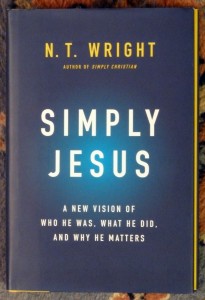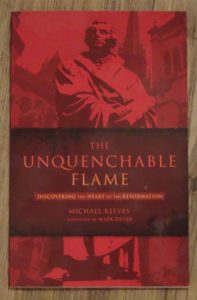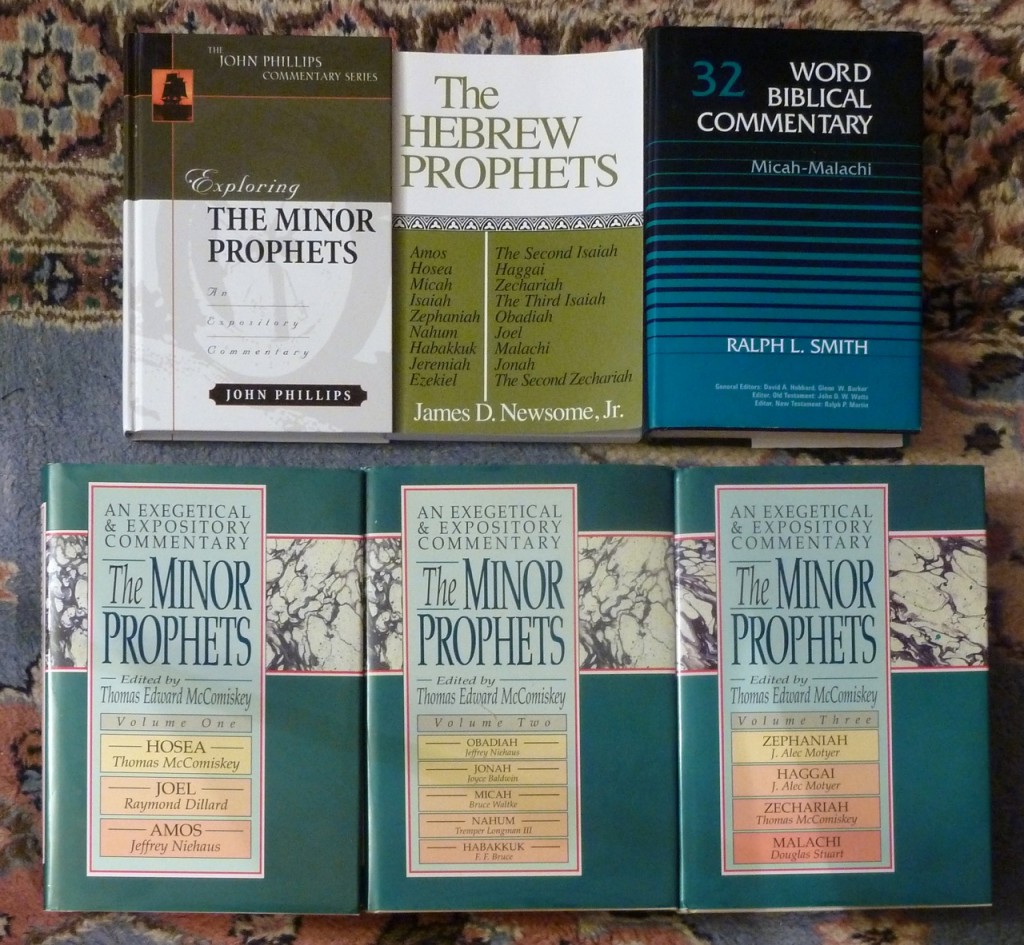Simply Jesus: A New Vision of Who He Was, What He Did, and Why He Matters (2011) was the focus of our summer book club at Trinity CRC and the second N.T. Wright book we’ve read. In 2008, our book was Surprised by Hope.

Both books are part of a succession of N.T. Wright books aimed at a popular audience and published in the U.S. by HarperOne over the past eight years. The first four—Simply Christian: Why Christianity Makes Sense (2006), Surprised by Hope: Rethinking Heaven, the Resurrection and the MIssion of the Church (2006), After You Believe: Why Christian Character Matters (2010) and Scripture and the Authority of God: How to Read the Bible Today (2011; an updated version of 2005’s The Last Word)—together form a fantastic overview of the Christian faith.
Wright’s next two books (with a different cover design from Simply Christian tetralogy)—Simply Jesus and How God Became King: The Forgotten Story of the Gospels (2012)—are Wright’s popularization of his scholarship on Jesus, found especially in Jesus and the Victory of God (1996), probably my favorite of his books, but updated to reflect another 18 years of study.
(Wright has already published two more books with HarperOne—The Case for the Psalms: Why They Are Essential (2013), which I found disappointing, and Surprised by Scripture: Engaging Contemporary Issues (2014), which was just released.)
Eleven observations about Simply Jesus, which I’ve now read twice:
1. Wright frames Simply Jesus as an attempt to explain what Jesus was up to in historical context as a corrective to both contemporary skepticism and contemporary conservative Christianity. Since he ends up, quite expectedly, with a version of orthodox Christianity, I’m not sure how effective this framing device would be for a contemporary skeptic.
2. Regarding the skeptics, Wright pokes holes in their alternative accounts of how Christianity got started and how the stories of Jesus developed. Wright’s corrective to the conservatives is to insist that Jesus’ ministry had significance beyond accomplishing “atonement” so Christians could “go to heaven when they die.” In other words, Wright is concerned with how Jesus’ ministry was understood by his early followers and Jesus himself and not just how he fits into orthodox theology. (Wright repeats his objections to the “rapture” and “going to heaven when we die” found in Surprised by Hope, but he doesn’t address his claims about justification that have generated some controversy among evangelicals.)
3. Wright’s love of extended metaphors is on display here in the meteorological realm. Skepticism and conservatism are “two violent winds” resulting in a “perfect storm.” The challenge of writing history about Jesus is a “tropical storm.” Another “perfect storm” in the First Century was the result of “the Gale of Rome,” “the high-pressure system of Jewish hopes,” and the “wind of God.” And so on. (Paul and the Faithfulness of God, which I’m reading now, does the same with bird metaphors.)
4. Most of the book is an historical investigation of the significance of Jesus’ ministry in the context of Jewish religion and history, particularly the Jews’ subjugation to Rome and how this was experienced as another captivity in need of an Exodus so that God’s rule could be made evident. Major events in Jesus’ ministry are put into this context—his Temptation, the “Nazareth Manifesto,” Jesus forgiving the sins of the woman who anointed his feet, John the Baptist’s conflict with Herod, Cleansing the Temple, several key parables (The Rich Man and Lazarus, The Sower, The Wicked Tenants).
5. Wright also does a nice job of interpreting parts of the Jesus story through both Jewish and Roman lenses. For instance, the Ascension is both an enthronement à la Daniel’s Son of Man and an upstaging of the purported apotheosis of Julius Caesar.
6. One of Wright’s arguments in Jesus and the Victory of God is that Jesus took important symbols of Jewish identity—Sabbath, Temple, family, Taroh, land, food—and redefined them around himself. Traces of this can be found here, but it’s been repackaged as a discussion of “Space, Time, and Matter” (which he developed earlier in Surprised by Hope). I think I like the earlier version better.
7. One of my favorite insights from Jesus and the Victory of God, repeated here, is that Jesus worked out his vocation through engagement with Scripture. The traditional evangelical understanding of Old Testament prophetic passages referring to Jesus is that these passages are remarkable predictions that demonstrate the accuracy of the Bible and Jesus’ divinity. However, this understanding results in a Jesus who is just going through the motions, performing a series of preordained actions. Wright’s version has Jesus studying the Scriptures and creatively developing his vocation by bringing together passages in new ways. In particular, Wright sees Jesus drawing upon Isaiah 40-66’s Suffering Servant, Daniel’s Son of Man and Zechariah’s King, as well as the Psalms. This is a much more human Jesus and one that we can seek to emulate, working out our own vocation through interaction with Scripture.
8. One of the pleasures of reading Wright is encountering his fresh insights about familiar Scripture passages. For instance, on p. 180 Wright connects the Crucifixion to the Sermon on the Mount:
This would usher in the new era of blessing announced in the Sermon on the Mount and achieved by the same means that was explained on that occasion. Jesus, as the servant, turned the other cheek; Jesus, carrying his cross, went the extra mile at the behest of his Roman executioners; Jesus, finally, ended up enthroned, set on a hill, unable to be hidden, the light of the world shining out at the darkest moment in history.
The book is worth reading for these insights alone.
9. The last two chapters, which are two of the most dense, are about how Jesus’ resurrection brought about a new world in which God is King and the implications of this for the Church. How God Became King, which serves as a sequel to Simply Jesus, is an expansion and further explication of this idea.
10. Although the subtitles of Simply Jesus and How God Became King suggest this insight is either “new” or at least “forgotten,” his thesis seems broadly compatible with Reformed theology. This was the topic a blog post, “Kings, Creeds, and the Canon: Musing on N.T. Wright” by Jamie Smith, to which Wright responded in the comments. It’s worth reading.
11. Of special interest to me, Wright includes a great discussion of the “Centrality of Worship” for doing Kingdom work (p. 217):
All kingdom work is rooted in worship. Or, to put it the other way around, worshipping the God we see at work in Jesus is the most politically charged act we can ever perform. Christian worship declares that Jesus is Lord and therefore, by strong implication, nobody else is.… It commits the worshipper to allegiance, to following this Jesus, to being shaped and directed by him. Worshipping the God we see in Jesus orients our whole being, our imagination, our will, our hopes, and our fears away from the world where Mars, Mammon, and Aphrodite (violence, money, and sex) make absolute demands and punish anyone who resists. It orients us instead to a world in which love is stronger than death, the poor are promised the kingdom, and chastity (whether married or single) reflects the holiness and faithfulness of God himself.… Worship creates—or should create, if it is allowed to be truly itself—a community that marches to a different beat, that keeps in step with a different Lord.
Highly recommended
 Chapter 2 is on the life and career of Martin Luther. Chapter 3 covers Ulrich Zwingli and the Radical Reformation, which Reeves says includes the Anabaptists, Spiritualists and Rationalists. I could have used more about the Anabaptists; Menno Simons gets less than a page. Chapter 4 covers John Calvin and beginnings of Calvinism.
Chapter 2 is on the life and career of Martin Luther. Chapter 3 covers Ulrich Zwingli and the Radical Reformation, which Reeves says includes the Anabaptists, Spiritualists and Rationalists. I could have used more about the Anabaptists; Menno Simons gets less than a page. Chapter 4 covers John Calvin and beginnings of Calvinism.
